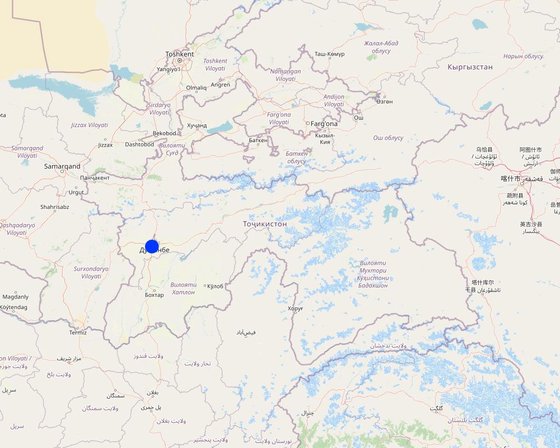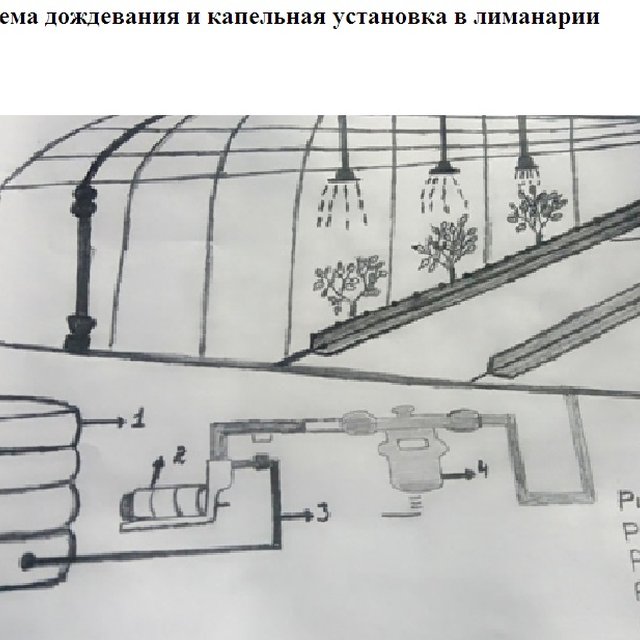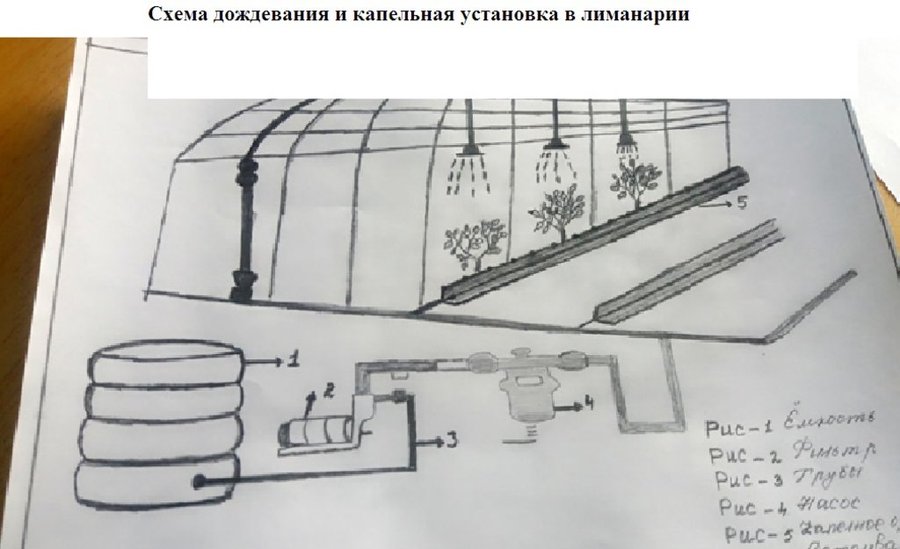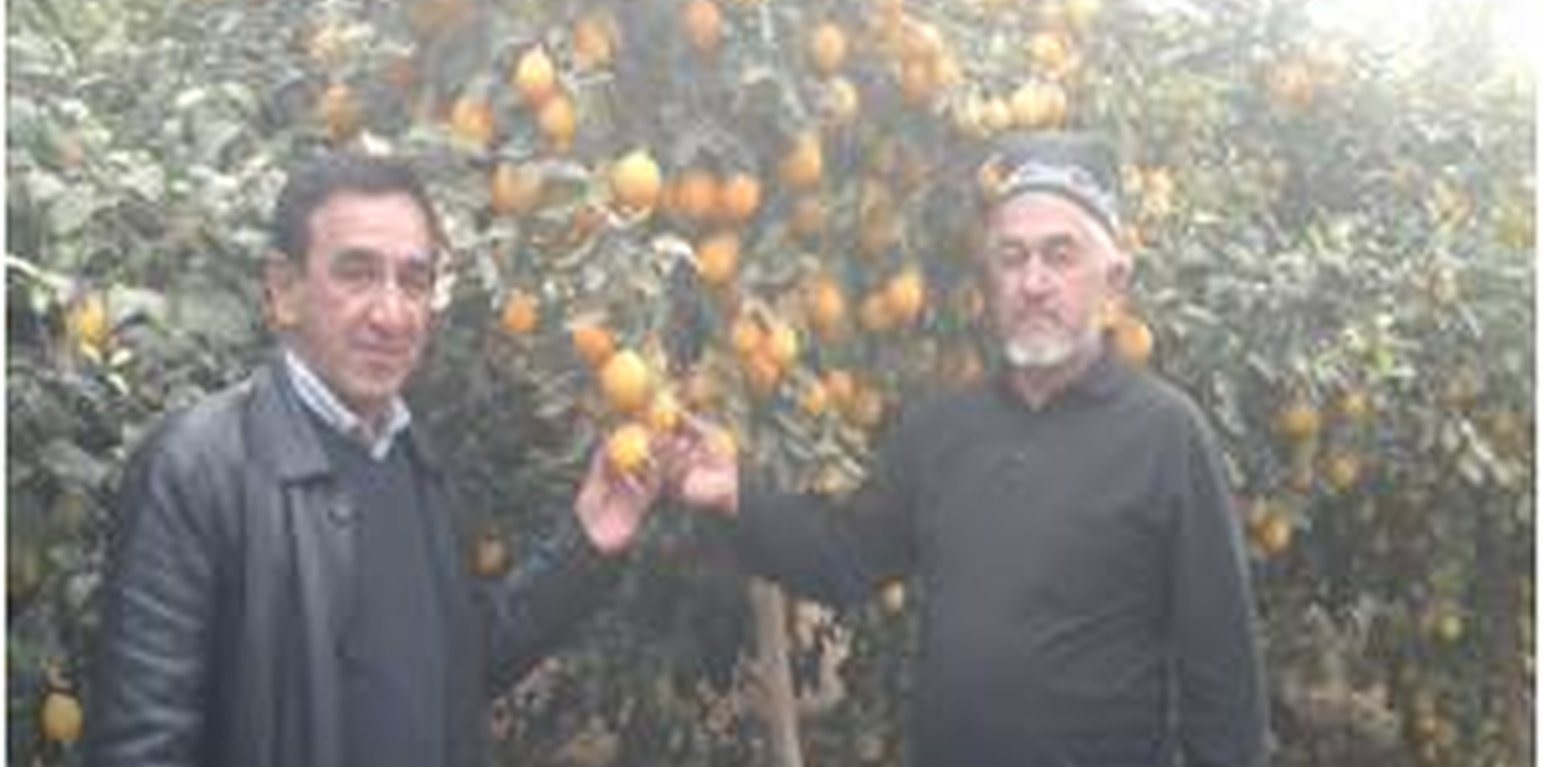Снижения водопотрибление цитрусовых культур в типличных условиях
(Tajikistan)
Истифодаи самараноки об дар лимонхонахо.
Description
Дождевальная технология облегчает ручной труд фермера и улучшет процес фотосинтеза путем смывания с листьев пыля за счет этого рост и развитие растении цитрусовых культур.
Одновременно повышается урожайность и качеств, плодов а также экономится вода при поливе и снижается эрозия почвы. Эта технология не применялась ранее в производстве оно находится в стадии доработки в опытном хозяйстве «Навбахор» Рудакинского района и дает хорошие результаты. Преимуществ заключается в том, что уменьшается объем рабочей силы, трудоемкая работа механизирована. Основной результат деятельности технологии в эконом воды промывке листьев и полива. Облегчается применение ядохимикатов во время опрыскивания также не происходит деградации почвы. Система дождевания в теплицах предназначен для полива растений сверху и применения препаратов против вредителей и болезней а также для внекорневой подкормки цитрусовых культур. Система используется специальными распылительными насадками, которые подключаются к шлангу, по которому подается вода. Для этой технологии необходимо применять трубы, дождевалки на каждые 2 метра, краники, фильтр, насос, емкость для воды (бочка). Одновременно можно установить капельное орошение, которое можно использовать в лимонариях.
Эта технология землепользователям нравится, поскольку одновременно с одним опрыскиванием можно провести четыре операции: промывку против пыли, внекорневую подкормку с применением минеральных удобрении опрыскиванием ядохимикатом против болезней и вредителей и полив.
Location

Location: Участок "Навбахор", РРП, Tajikistan
No. of Technology sites analysed: single site
Geo-reference of selected sites
Spread of the Technology: applied at specific points/ concentrated on a small area
In a permanently protected area?:
Date of implementation: 2017; less than 10 years ago (recently)
Type of introduction
-
through land users' innovation
-
as part of a traditional system (> 50 years)
-
during experiments/ research
-
through projects/ external interventions

Схема дождевания лимона и капельного орощения. . (Сангинов Б.)
Classification of the Technology
Main purpose
-
improve production
-
reduce, prevent, restore land degradation
-
conserve ecosystem
-
protect a watershed/ downstream areas – in combination with other Technologies
-
preserve/ improve biodiversity
-
reduce risk of disasters
-
adapt to climate change/ extremes and its impacts
-
mitigate climate change and its impacts
-
create beneficial economic impact
-
create beneficial social impact
Land use
-
Cropland
Number of growing seasons per year: 1
Water supply
-
rainfed
-
mixed rainfed-irrigated
-
full irrigation
Purpose related to land degradation
-
prevent land degradation
-
reduce land degradation
-
restore/ rehabilitate severely degraded land
-
adapt to land degradation
-
not applicable
Degradation addressed
-
soil erosion by water - Wt: loss of topsoil/ surface erosion
SLM group
-
improved ground/ vegetation cover
-
minimal soil disturbance
-
cross-slope measure
SLM measures
-
agronomic measures - A1: Vegetation/ soil cover
-
vegetative measures - V1: Tree and shrub cover
-
structural measures - S7: Water harvesting/ supply/ irrigation equipment
Technical drawing
Technical specifications
None

Author: Сангинов Б.
Establishment and maintenance: activities, inputs and costs
Calculation of inputs and costs
- Costs are calculated: per Technology area (size and area unit: На 1\га.; conversion factor to one hectare: 1 ha = 10000 м. квадрат.)
- Currency used for cost calculation: USD
- Exchange rate (to USD): 1 USD = 8.9
- Average wage cost of hired labour per day: 3.0
Most important factors affecting the costs
Наиболее значимые затраты это строй материалы, насос,труба, шланги , и.т.д.
Establishment activities
-
пласмассовые трубы (Timing/ frequency: март)
-
Муфта (Timing/ frequency: март)
-
Филтер (Timing/ frequency: апрел)
-
Насос (Timing/ frequency: В течение установки)
-
насадка (Timing/ frequency: В течение установки)
-
краники (Timing/ frequency: во время установки)
-
клапан (Timing/ frequency: во время установки)
-
Шланг для капельного орошения (Timing/ frequency: Вовремя установки)
-
Цистерна (Бочка для воды) (Timing/ frequency: Вовремя установки.)
Establishment inputs and costs (per На 1\га.)
| Specify input |
Unit |
Quantity |
Costs per Unit (USD) |
Total costs per input (USD) |
% of costs borne by land users |
|
Labour
|
| Ручная работа |
день |
20.0 |
5.5 |
110.0 |
100.0 |
|
Equipment
|
| Труба ,шланг, филтер |
|
1.0 |
1080.0 |
1080.0 |
100.0 |
|
Plant material
|
| саженцы лимона |
шт |
133.0 |
3.3 |
438.9 |
100.0 |
|
Construction material
|
| Стойка трубы |
день |
133.0 |
3.3 |
438.9 |
100.0 |
| Total costs for establishment of the Technology |
2'067.8 |
|
| Total costs for establishment of the Technology in USD |
232.34 |
|
Maintenance activities
n.a.
Maintenance inputs and costs (per На 1\га.)
| Specify input |
Unit |
Quantity |
Costs per Unit (USD) |
Total costs per input (USD) |
% of costs borne by land users |
|
Labour
|
| Ручная работа |
день |
20.0 |
5.5 |
110.0 |
19.0 |
|
Construction material
|
| стойка трубы. и.т.д. |
м |
30.0 |
3.1 |
93.0 |
100.0 |
| Total costs for maintenance of the Technology |
203.0 |
|
| Total costs for maintenance of the Technology in USD |
22.81 |
|
Natural environment
Average annual rainfall
-
< 250 mm
-
251-500 mm
-
501-750 mm
-
751-1,000 mm
-
1,001-1,500 mm
-
1,501-2,000 mm
-
2,001-3,000 mm
-
3,001-4,000 mm
-
> 4,000 mm
Agro-climatic zone
-
humid
-
sub-humid
-
semi-arid
-
arid
Specifications on climate
осадка выпадает на долинных местах не очень много в основном где выращивается лимоны это Южная и восточная часть по этому осадка не очень играет важную роль
Name of the meteorological station: ГМС, г.Душанбе.
Зона выращиваемый лимона в основном засушливая жаркие регионы.
Slope
-
flat (0-2%)
-
gentle (3-5%)
-
moderate (6-10%)
-
rolling (11-15%)
-
hilly (16-30%)
-
steep (31-60%)
-
very steep (>60%)
Landforms
-
plateau/plains
-
ridges
-
mountain slopes
-
hill slopes
-
footslopes
-
valley floors
Altitude
-
0-100 m a.s.l.
-
101-500 m a.s.l.
-
501-1,000 m a.s.l.
-
1,001-1,500 m a.s.l.
-
1,501-2,000 m a.s.l.
-
2,001-2,500 m a.s.l.
-
2,501-3,000 m a.s.l.
-
3,001-4,000 m a.s.l.
-
> 4,000 m a.s.l.
Technology is applied in
-
convex situations
-
concave situations
-
not relevant
Soil depth
-
very shallow (0-20 cm)
-
shallow (21-50 cm)
-
moderately deep (51-80 cm)
-
deep (81-120 cm)
-
very deep (> 120 cm)
Soil texture (topsoil)
-
coarse/ light (sandy)
-
medium (loamy, silty)
-
fine/ heavy (clay)
Soil texture (> 20 cm below surface)
-
coarse/ light (sandy)
-
medium (loamy, silty)
-
fine/ heavy (clay)
Topsoil organic matter content
-
high (>3%)
-
medium (1-3%)
-
low (<1%)
Groundwater table
-
on surface
-
< 5 m
-
5-50 m
-
> 50 m
Availability of surface water
-
excess
-
good
-
medium
-
poor/ none
Water quality (untreated)
-
good drinking water
-
poor drinking water (treatment required)
-
for agricultural use only (irrigation)
-
unusable
Water quality refers to:
Is salinity a problem?
Occurrence of flooding
Characteristics of land users applying the Technology
Market orientation
-
subsistence (self-supply)
-
mixed (subsistence/ commercial)
-
commercial/ market
Off-farm income
-
less than 10% of all income
-
10-50% of all income
-
> 50% of all income
Relative level of wealth
-
very poor
-
poor
-
average
-
rich
-
very rich
Level of mechanization
-
manual work
-
animal traction
-
mechanized/ motorized
Sedentary or nomadic
-
Sedentary
-
Semi-nomadic
-
Nomadic
Individuals or groups
-
individual/ household
-
groups/ community
-
cooperative
-
employee (company, government)
Age
-
children
-
youth
-
middle-aged
-
elderly
Area used per household
-
< 0.5 ha
-
0.5-1 ha
-
1-2 ha
-
2-5 ha
-
5-15 ha
-
15-50 ha
-
50-100 ha
-
100-500 ha
-
500-1,000 ha
-
1,000-10,000 ha
-
> 10,000 ha
Scale
-
small-scale
-
medium-scale
-
large-scale
Land ownership
-
state
-
company
-
communal/ village
-
group
-
individual, not titled
-
individual, titled
Land use rights
-
open access (unorganized)
-
communal (organized)
-
leased
-
individual
Water use rights
-
open access (unorganized)
-
communal (organized)
-
leased
-
individual
Access to services and infrastructure
employment (e.g. off-farm)
drinking water and sanitation
Impacts
Socio-economic impacts
Crop production
До применение технологии расход воды больше и много ручных работ после применения вся это сокрашается на 50 %
crop quality
До применения качество намного хуже было после применения стало лучше на 60%
Cost-benefit analysis
Benefits compared with establishment costs
Short-term returns
very negative
very positive
Long-term returns
very negative
very positive
Benefits compared with maintenance costs
Short-term returns
very negative
very positive
Long-term returns
very negative
very positive
Climate change
Gradual climate change
annual temperature increase
not well at all
very well
seasonal temperature increase
not well at all
very well
not well at all
very well
seasonal rainfall decrease
not well at all
very well
Climate-related extremes (disasters)
not well at all
very well
local sandstorm/ duststorm
not well at all
very well
not well at all
very well
not well at all
very well
extreme winter conditions
not well at all
very well
not well at all
very well
Adoption and adaptation
Percentage of land users in the area who have adopted the Technology
-
single cases/ experimental
-
1-10%
-
11-50%
-
> 50%
Of all those who have adopted the Technology, how many have done so without receiving material incentives?
-
0-10%
-
11-50%
-
51-90%
-
91-100%
Number of households and/ or area covered
Число домохозяйств под этим технологии пока нет это все научно исследовательская эксперимент который даёт уже хорошие результаты.
Has the Technology been modified recently to adapt to changing conditions?
To which changing conditions?
-
climatic change/ extremes
-
changing markets
-
labour availability (e.g. due to migration)
Conclusions and lessons learnt
Strengths: land user's view
-
Эконом воды, уменьшения ручных работ
-
Одновременно проведения обработки против вредителей и болезни и полив дождевания.
-
поддерживает дисбаланс растений.
Strengths: compiler’s or other key resource person’s view
-
эконом воды, уменьшения ручных работ
-
Одновременно проведения обработки против вредителей и болезни и полив дождевания
-
поддерживает дисбаланс растений.
Weaknesses/ disadvantages/ risks: land user's viewhow to overcome
-
дороговизна оборудования и материалы.
Weaknesses/ disadvantages/ risks: compiler’s or other key resource person’s viewhow to overcome
-
дороговизна оборудования и материалы.
References
Reviewer
-
Farrukh Nazarmavloev
-
Joana Eichenberger
Date of documentation: Mei 8, 2018
Last update: Aug. 19, 2024
Resource persons
-
Rustam Kalandarov - SLM specialist
-
Бахром бобоевич Сангинов - land user
Full description in the WOCAT database
Documentation was faciliated by
Institution
- Youth Ecological Center, Tajikistan (Youth Ecological Center, Tajikistan) - Tajikistan
Project
- Environmental Land Management and Rural Livelihoods (ELMAR)











